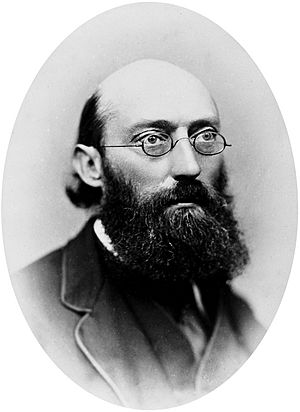George Buchanan (physician) facts for kids
Quick facts for kids
George Buchanan
|
|
|---|---|
 |
|
| Born | 5 November 1831 Myddleton Square, Islington, London, UK
|
| Died | 5 May 1895 (aged 63) Fitzroy House, Fitzroy Square, London, UK
|
Sir George Buchanan (born November 5, 1831 – died May 5, 1895) was an important English doctor and public servant. He was an epidemiologist, which means he studied how diseases spread and how to control them. Sir George Buchanan was also the Chief Medical Officer for the United Kingdom from 1879 to 1892. This was a very important job, like being the country's top doctor for public health.
Contents
Sir George Buchanan: A Public Health Hero
Early Life and Medical Training
George Buchanan was born in London. He was the older son of George Adam Buchanan, who was also a doctor. George studied medicine at the University College London and the University of London. He finished his studies in 1854.
From 1855 to 1860, he worked as a doctor at the Great Ormond Street Hospital. This hospital cared for sick children. In 1858, he also opened his own medical practice. Later, from 1861 to 1868, he worked at the London Fever Hospital.
Fighting Diseases and Improving Health
Sir George Buchanan is best known for his amazing work in public health. In 1856, he became the first medical officer for an area in London called St Giles. This area had the highest death rate in London. He studied the area carefully and wrote reports about how to stop infectious diseases. Because of his work, he became a national expert on public health.
Tackling Smallpox and Typhus
One of his most important achievements was his work on smallpox vaccination. His research helped create the Vaccination Act of 1867. This law made vaccination more common and helped protect many people from smallpox.
He also studied typhus, a serious disease. During a difficult time called the Lancashire Cotton Famine in 1862, he wrote important notes about how typhus was spreading. His ideas helped fight the disease in cities like Liverpool and Warrington. Thanks to his work, typhus was almost completely gone from the country after the 1870s. Buchanan realized that typhus spread easily in crowded, dirty places. He also found that improving drainage and making soil less damp helped reduce deaths from tuberculosis, a lung disease.
Leading Public Health Efforts
In 1869, Buchanan became an inspector for the medical department of the government. Then, in 1879, he was appointed the Chief Medical Officer of the United Kingdom. This was a very high position where he could make big changes to improve the health of everyone in the country.
He retired from this role in 1892 and was given the title of "Sir" (knighted) for his great service. After that, he became the head of a special group called the Royal Commission on Tuberculosis.
Buchanan always stayed connected with the University College London. He even helped make it possible for women to study at the University College and the University of London.
His Family and Legacy
Sir George Buchanan was married twice. He had two sons and four daughters from his marriages. He died in 1895 from heart failure.
His elder son, Sir George Seaton Buchanan, also became a famous doctor and epidemiologist, just like his father. One of his daughters, Anna Maud Buchanan, was very well educated. She studied classical languages and became a teacher and translator.
The Buchanan Medal
To honor Sir George Buchanan's important work, the Royal Society started giving out a special award in 1897. This award is a gold medal given for great achievements in public health. It is called the Buchanan Medal, and it even has his picture on it!
See also

